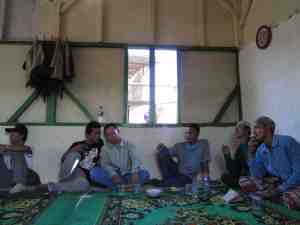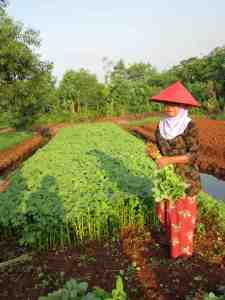by Raisa
In Indonesian, kampung is translated literally as “community” or “village,” but considered in Jakarta to be a slum neighborhood. To walk into a kampung is to walk into an intensely private, interconnected, and intimate space. For the residents, home is both the narrow mud street between plywood shacks and the clean-swept tiles within.
Catherine, Jasmine and I were lucky to be taken into one of the kampung of northern Jakarta last week with the field coordinator and secretary of the Urban Poor Consortium. The UPC operates throughout Jakarta and the rest of Indonesia to provide community organizing and political advocacy, working as a voice for the often-unregistered citizens who dwell in the slums and communities that are unrecognized by the government. After spending the morning with the UPC staff members, we drove through heavy traffic and by soaring skyscrapers and ritzy condominiums to a kampung named Kebon Bayem (“Spinach Garden” in English). Here, 450 families have built homes in a cramped space by the railroad tracks.
I have been to slums and poor neighborhoods before. Often I feel like an intruder staring at a spectacle. But at Kebon Bayem, I did not. We were immediately welcomed by the community leaders with whom the UPC works. Eager to show us their village and share their stories of frustration and resilience, we were invited into the humble mosque they built themselves, a plywood-and-corrugated-tin affair with white tile floors. As we settled ourselves cross-legged on the floor, residents began to crowd in; first the men, then women and children who peered in through the open door.
For two uninterrupted hours we spoke with the community leaders. The buzzing of flies, the air heavy with cigarette smoke, the shrieks of children outside, the stiffness of my crossed legs: despite these distractions, I didn’t for a moment want to be anywhere else. Never mind the sweat dripping down my face and the uncomfortable way my shirt stuck to my back. This was my first field visit as a reporter, not just a tourist. Each face and voice presented a story to tell. Each detail fascinated me.
When we tired of questioning, we were invited to attend a religious ceremony celebrating the seven-month birthday of a baby in the kampung. After the prayer chants were completed, and after each man present in the mosque had cut off a small tuft of the baby’s hair, a feast was served to us from a huge communal bowl covered with banana leaves and filled with rice, soybean cakes, noodles, chicken, and vegetables. We ate as everyone else did: with our hands, and sitting on the floor.
As the afternoon came to a close, we were brought to the spinach garden that some of the kampung residents farm. In the distance, huge villas and apartment complexes loomed. But the elderly woman pulling spinach right next to us, in her colorful sarong and round hat, could have been from any rural community in Indonesia in the last few centuries.
When I left Kebon Bayem, I felt like I finally had a grasp on Jakarta. Many find it complicated, overdeveloped in some aspects and underdeveloped in others, as I had too upon arrival. And while I may never understand what makes this city’s heart beat, I knew I had connected with real people in real, tangible communities, and with that Jakarta came alive for me.


